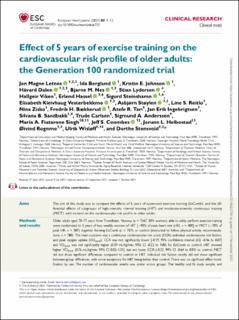| dc.contributor.author | Letnes, Jon Magne | |
| dc.contributor.author | Berglund, Ida Johnsen | |
| dc.contributor.author | Johnson, Kristin Espolin | |
| dc.contributor.author | Dalen, Håvard | |
| dc.contributor.author | Nes, Bjarne | |
| dc.contributor.author | Lydersen, Stian | |
| dc.contributor.author | Viken, Hallgeir | |
| dc.contributor.author | Hassel, Erlend | |
| dc.contributor.author | Steinshamn, Sigurd Loe | |
| dc.contributor.author | Vesterbekkmo, Elisabeth Kleivhaug | |
| dc.contributor.author | Støylen, Asbjørn | |
| dc.contributor.author | Reitlo, Line Skarsem | |
| dc.contributor.author | Zisko, Nina | |
| dc.contributor.author | Bækkerud, Fredrik Hjulstad | |
| dc.contributor.author | Tari, Atefe R | |
| dc.contributor.author | Ingebrigtsen, Jan Erik | |
| dc.contributor.author | Bucher Sandbakk, Silvana | |
| dc.contributor.author | Carlsen, Trude | |
| dc.contributor.author | Anderssen, Sigmund Alfred | |
| dc.contributor.author | Singh, Maria A. Fiatarone | |
| dc.contributor.author | Coombes, Jeff S. | |
| dc.contributor.author | Helbostad, Jorunn L. | |
| dc.contributor.author | Rognmo, Øivind | |
| dc.contributor.author | Wisløff, Ulrik | |
| dc.contributor.author | Stensvold, Dorthe | |
| dc.date.accessioned | 2021-11-16T12:32:00Z | |
| dc.date.available | 2021-11-16T12:32:00Z | |
| dc.date.created | 2021-11-08T21:49:20Z | |
| dc.date.issued | 2021 | |
| dc.identifier.issn | 0195-668X | |
| dc.identifier.uri | https://hdl.handle.net/11250/2829838 | |
| dc.description.abstract | Aims The aim of this study was to compare the effects of 5 years of supervised exercise training (ExComb), and the differential effects of subgroups of high-intensity interval training (HIIT) and moderate-intensity continuous training (MICT), with control on the cardiovascular risk profile in older adults. Methods and results Older adults aged 70–77 years from Trondheim, Norway (n = 1567, 50% women), able to safely perform exercise training were randomized to 5 years of two weekly sessions of HIIT [∼90% of peak heart rate (HR), n = 400] or MICT (∼70% of peak HR, n = 387), together forming ExComb (n = 787), or control (instructed to follow physical activity recommendations, n = 780). The main outcome was a continuous cardiovascular risk score (CCR), individual cardiovascular risk factors, and peak oxygen uptake (VO2peak). CCR was not significantly lower [−0.19, 99% confidence interval (CI) −0.46 to 0.07] and VO2peak was not significantly higher (0.39 mL/kg/min, 99% CI −0.22 to 1.00) for ExComb vs. control. HIIT showed higher VO2peak (0.76 mL/kg/min, 99% CI 0.02–1.51), but not lower CCR (−0.32, 99% CI −0.64 to 0.01) vs. control. MICT did not show significant differences compared to control or HIIT. Individual risk factors mostly did not show significant between-group differences, with some exceptions for HIIT being better than control. There was no significant effect modification by sex. The number of cardiovascular events was similar across groups. The healthy and fit study sample, and contamination and cross-over between intervention groups, challenged the possibility of detecting between-group differences. Conclusions Five years of supervised exercise training in older adults had little effect on cardiovascular risk profile and did not reduce cardiovascular events. ClinicalTrials.gov: NCT01666340 | en_US |
| dc.language.iso | eng | en_US |
| dc.publisher | Oxford University Press | en_US |
| dc.rights | Navngivelse-Ikkekommersiell 4.0 Internasjonal | * |
| dc.rights.uri | http://creativecommons.org/licenses/by-nc/4.0/deed.no | * |
| dc.title | Effect of 5 years of exercise training on the cardiovascular risk profile of older adults: the Generation 100 randomized trial | en_US |
| dc.type | Peer reviewed | en_US |
| dc.type | Journal article | en_US |
| dc.description.version | publishedVersion | en_US |
| dc.source.journal | European Heart Journal | en_US |
| dc.identifier.doi | 10.1093/eurheartj/ehab721 | |
| dc.identifier.cristin | 1952565 | |
| cristin.ispublished | true | |
| cristin.fulltext | original | |
| cristin.qualitycode | 2 | |

